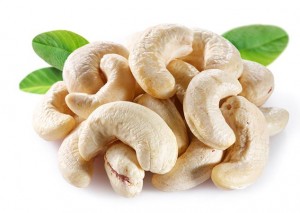Die fein gewürzt Cashewnuss ist ein beliebtes zwischen Mahlzeit Snacks, die leicht in Ihrem lokalen Markt das ganze Jahr über zu finden sind. Es macht auch wunderbare Nussbutter und eine besondere Bereicherung für Salate und Wok-Gerichten.
Cashewnüsse sind eigentlich die nierenförmigen Samen, die an der Unterseite des Cashewapfel, der Frucht des Cashew-Baum haften, die den Küstengebieten im Nordosten von Brasilien heimisch ist. Cashew-Kerne sind immer geschält verkauft, weil der Innenraum der Schalen eine ätzende Harz enthält, wie Cashew-Balsam bekannt, die sorgfältig entfernt werden muss, bevor die Nüsse zum Verzehr geeignet sind. Diese ätzende Harz wird in der Industrie tatsächlich verwendeten Lacke und Insektizide zu machen.
Nutzen für die Gesundheit
Herz-Schutz einfach ungesättigte Fette
Nicht nur, dass Cashewnüsse haben einen geringeren Fettgehalt als die meisten anderen Nüssen, etwa 82% von ihrem Fett ist ungesättigten Fettsäuren, plus ca. 66% dieser Anteil an ungesättigten Fettsäuren sind Herz-gesunde einfach ungesättigte Fette, ähnlich denen in Olivenöl gefunden. Studium der Diabetes-Patienten zeigen, dass einfach ungesättigte Fettsäuren, wenn sie auf eine fettarme Ernährung aufgenommen, helfen kann, hohe Triglyzeride zu senken. Triglyzeride sind eine Form, in der Fette im Blut durchgeführt werden, und hohe Triglyzeride sind mit einem erhöhten Risiko für Herzkrankheiten , so gewährleisten Sie einige einfach ungesättigte Fette in der Ernährung haben von Cashew-Kerne ist eine gute Idee, vor allem für Personen mit Diabetes genießen.
Kupfer für antioxidative Abwehr, Energieproduktion , Knochen und Blutgefäße
Ein wesentlicher Bestandteil vieler Enzyme, spielt Kupfer eine wichtige Rolle bei einer Vielzahl physiologischer Prozesse, einschließlich Eisen Verwertung, Beseitigung von freien Radikalen, die Entwicklung von Knochen und Bindegewebe, sowie die Herstellung von Haut und Haaren Pigment Melanin genannt. Beispielsweise Kupfer ist ein wesentlicher Bestandteil des Enzyms Superoxid-Dismutase, die bei der Energieerzeugung und antioxidative Abwehr wichtig ist. Kupfer ist auch notwendig für die Aktivität der Lysyloxidase, einem Enzym beteiligt in Vernetzungs Kollagen und Elastin, von denen beide stellen die Grundsubstanz und Flexibilität in Blutgefäße , Knochen und Gelenken. Niedrige Aufnahme von Kupfer kann auch mit einer erhöhten fäkalen Produktion von freien Radikalen und fäkale Wasser alkalische Phosphatase-Aktivität, die Risikofaktoren für Darmkrebs in Verbindung gebracht werden.
Knochen und entspannen mit Cashews
Jeder weiß, dass Calcium für starke Knochen notwendig ist, aber Magnesium ist auch wichtig für gesunde Knochen. Etwa zwei Drittel des Magnesiums in den menschlichen Körper ist in unseren Knochen gefunden. Einige hilft Knochen ihrer physikalischen Struktur geben, während der Rest auf der Oberfläche der Knochen gefunden wird, wo sie gespeichert werden, damit der Körper bei Bedarf zurückgreifen .
Magnesium, Kalzium durch Balancieren, hilft bei der Regulierung von Nerven und Muskeln Ton. In vielen Nervenzellen dient Magnesium als eigene Kalziumkanalblocker der Natur, Kalzium verhindern in die Nervenzelle aus Rauschen und die Nerven zu aktivieren. Durch die Blockade Kalzium-Beitritt, Magnesium hält die Nerven (und die Blutgefäße und Muskeln sie innervieren ) entspannt. Wenn unsere Ernährung uns mit zu wenig Magnesium sieht jedoch vor, kann Kalzium freien Eintritt gewinnen, und die Nervenzelle kann überaktiviert werden, das Senden zu viele Nachrichten und übermäßige Kontraktion verursacht.
Zu wenig Magnesium kann somit zu hohen Blutdruck , Muskelkrämpfe (einschließlich Krämpfe des Herzmuskels oder der Krämpfe der Atemwege symptomatisch für Asthma) und Migräne-Kopfschmerzen sowie Muskelkrämpfe , Verspannungen, Schmerzen und Müdigkeit bei. Angesichts dieser Effekte ist es nicht verwunderlich, dass Studien gezeigt haben, Magnesium hilft, die Häufigkeit von Migräneattacken reduzieren, senkt den Blutdruck , hilft Herzinfarkte, fördert die normale Schlafmuster bei Frauen leiden unter den Wechseljahren Schlafstörungen, und reduziert die Schwere von Asthma.
Zu verhindern, dass Gallensteine
Zwanzig Jahre von Nahrungs auf 80.000 Frauen gesammelten Daten aus der Nurses ‘Health Study zeigt, dass Frauen, die essen mindestens 1 Unze Nüsse, Erdnüsse oder Erdnussbutter jede Woche um 25% geringeres Risiko der Entwicklung von Gallensteinen haben. Seit 1 Unze nur 28,6 Nüsse oder etwa 2 EL Nussbutter ist, Erkrankungen der Gallenblase verhindern kann als Verpackung ein Cashew Butter und Marmelade-Sandwich so einfach sein (achten Sie darauf, für seine Ballaststoffe, Vitamine und Mineralstoffe , Vollkornbrot zu verwenden) für das Mittagessen pro Woche Pick me, als einen Nachmittag eine Handvoll Cashewnüsse Atomen oder einige Cashewnüsse auf Ihrem Haferflocken oder Salat zu werfen.
Wie genießen
Ein paar schnelle Serving-Ideen
- Cashew-Kerne mit anderen Nüssen und Trockenfrüchten macht einen gesunden Snack zu kombinieren.
- Kurz vor der Hitze Ausziehen hinzufügen Cashewkerne zu gesunden sautiertem Gemüse.
- Gesunde anbraten Cashews mit Garnelen, Basilikum und grünen Bohnen für einen schönen Thai inspiriert Gericht.
- Cashews mit ein wenig Ahornsirup ein großes Richtfest für heiße Getreide machen.
- In Cashew Butter zum Frühstück Soja- oder Reismilch schüttelt ihre Proteingehalt zu hoch (ein Viertel-Tasse Cashews bietet mehr als 5 Gramm Eiweiß) und ihnen eine cremige nussigen Geschmack.
- In einem Topf bei niedriger bis mittlerer Hitze, mischen Cashew Butter mit etwas Sojasauce , Cayennepfeffer , Knoblauch, Ingwer und Wasser eine wunderbare Sauce für Fisch, Gemüse, Tofu und Reis zu machen.
- Zum Braten Cashewnüsse zu Hause, tun so sanft in einem 160-170 ° F (etwa 75 ° C) Ofen für 15 bis 20 Minuten zu den gesunden Ölen bewahren.



